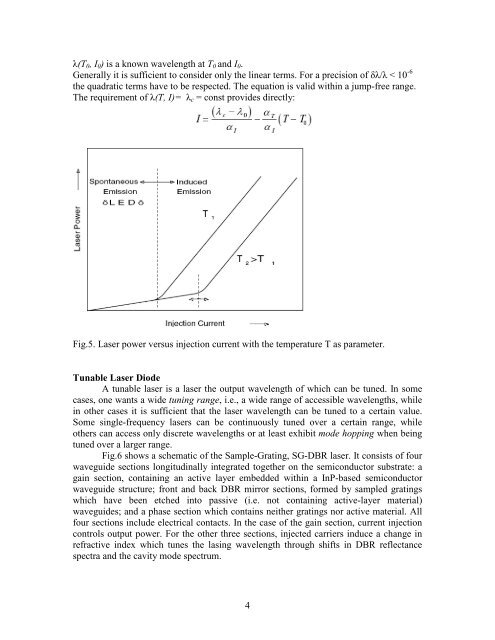ECE 183 2012 Lab #3 Tunable laser diode (Agility)
ECE 183 2012 Lab #3 Tunable laser diode (Agility)
ECE 183 2012 Lab #3 Tunable laser diode (Agility)
Create successful ePaper yourself
Turn your PDF publications into a flip-book with our unique Google optimized e-Paper software.
λ(T0, I0) is a known wavelength at T0 and I0.<br />
Generally it is sufficient to consider only the linear terms. For a precision of δλ/λ < 10 -6<br />
the quadratic terms have to be respected. The equation is valid within a jump-free range.<br />
The requirement of λ(T, I)= λc = const provides directly:<br />
Fig.5. Laser power versus injection current with the temperature T as parameter.<br />
<strong>Tunable</strong> Laser Diode<br />
A tunable <strong>laser</strong> is a <strong>laser</strong> the output wavelength of which can be tuned. In some<br />
cases, one wants a wide tuning range, i.e., a wide range of accessible wavelengths, while<br />
in other cases it is sufficient that the <strong>laser</strong> wavelength can be tuned to a certain value.<br />
Some single-frequency <strong>laser</strong>s can be continuously tuned over a certain range, while<br />
others can access only discrete wavelengths or at least exhibit mode hopping when being<br />
tuned over a larger range.<br />
Fig.6 shows a schematic of the Sample-Grating, SG-DBR <strong>laser</strong>. It consists of four<br />
waveguide sections longitudinally integrated together on the semiconductor substrate: a<br />
gain section, containing an active layer embedded within a InP-based semiconductor<br />
waveguide structure; front and back DBR mirror sections, formed by sampled gratings<br />
which have been etched into passive (i.e. not containing active-layer material)<br />
waveguides; and a phase section which contains neither gratings nor active material. All<br />
four sections include electrical contacts. In the case of the gain section, current injection<br />
controls output power. For the other three sections, injected carriers induce a change in<br />
refractive index which tunes the lasing wavelength through shifts in DBR reflectance<br />
spectra and the cavity mode spectrum.<br />
4


